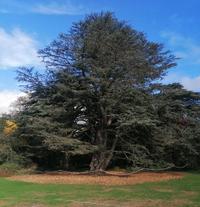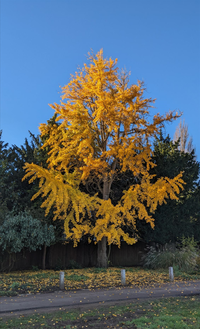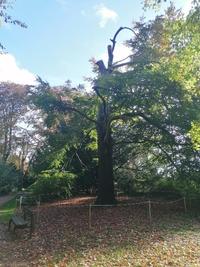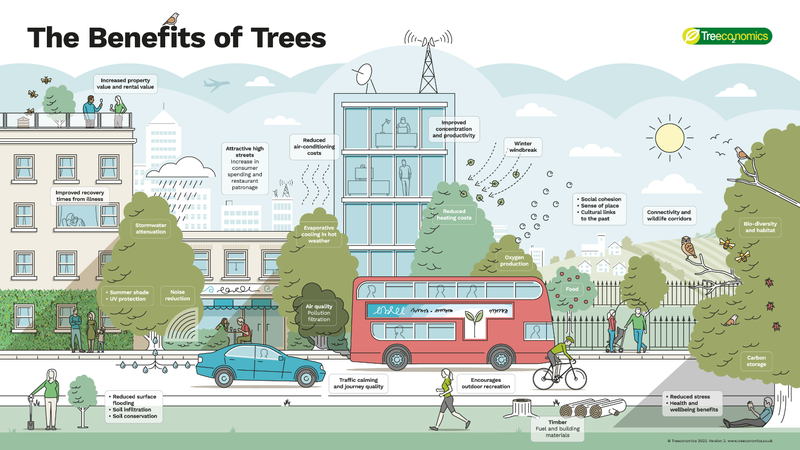Tree Management in the Parks

Blog by Samuel Prior, Arboricultural Manager
It doesn’t take visitors to the University Parks long to realise that this is a special place, and one of the things that makes it so special is its diverse collection of trees. In fact, there are around 1,700 of them in the park itself with more in Parsons Pleasure and along Mesopotamia Walk. What we have in the park today is largely thanks to the visionary approach of our predecessors, planting trees that in the most part they would never get to enjoy. A truly selfless act.

Cedrus atlantica (Atlantic cedar) near the North Walk, whose root plate the team have mulched to improve soil conditions
But for all this history, what is it that makes University Parks trees any different to most other city parks?
The answer is its close proximity to the University’s Botanic Garden (the oldest in the world), Harcourt Arboretum, and the Plant Sciences Department.
This has meant the park has had access to some of the most influential, knowledgeable and experienced individuals in the business, and with this expertise came a huge palette of different genera, species, varieties and cultivars.
As an example, did you know that there were around 40 different types of hawthorn along Thorn walk alone? To see these differences, look at the flowers in May and June and the haws (fruit) in autumn to see the great variety of shapes and colours. We have reason to believe this is the second largest collection of Thorn trees in the UK!

Autumn colour from a Ginkgo biloba (Maidenhair tree) in the Hayrick Border
The University Parks Arboricultural team now has the responsibility of managing this important resource, and it is our job to make sure trees under our management are not only safe and in good condition for visitors now, but are also fit for the enjoyment of park users of the future.
Our team’s tasks are varied, ranging from safety inspections, pruning and felling works, to providing advice to others, planting and watering, and strategic planning of our urban forest resource.
We undertake visual inspections of all of the trees we are responsible for every 18 months. We have recently completed the inspections in University Parks itself, and expect to undertake tree works from the survey early in 2024.
These works will be varied in their nature and range from formative pruning of small trees which will help them better develop, to end weight reductions of large heavy branches and even removal of whole trees where this is necessary.

Management of veteran trees in the Parks – maintaining a large Fagus sylvatica (Common Beech) at Nappers Arable
Despite sometimes being involved in tree removal, we are highly passionate about making sure our work is sustainable and minimises any disruption to wildlife.
I have a level 2 bat licence which enables me to assess trees for roosting potential before works are undertaken and where appropriate; we retain deadwood and standing dead trees for their habitat value.
Also, to aid with wildlife, we retain timber in habitat piles throughout the park and use the mulch to improve the soil conditions around existing trees.
This helps reduce the potential spread of pests and diseases and reduces the carbon involved in transporting materials from place to place.
The team feel very privileged and take a great pride in our work.
Outside of the park, as well as providing arboricultural services, we encourage others to look past the day-to-day issues that trees create and consider the many benefits they provide us in our urban spaces, many of which are shown on the infographic below:

Infographic by Treeconomics
Some useful figures on our work:
- So far in 2023, our team have surveyed 2,035 trees across the University functional estate (this includes all the University property that is used for academic and related purposes rather than being leased out or held as an investment).
- Earlier tree surveys showed we have 2,686 trees on the estate.
- Between November 2022 and March 2023, we have planted 33 trees across the estate including 27 trees and 19 different species inside University Parks alone!
- Between May and September, we watered 51 trees with 55 litres of water at least once a week. This is approximately 61,710 litres of water over this period. Trees are watered for the first three years, meaning that each tree receives around 3,630 litres of water during its establishment!
- We are planning to plant at least 14 more trees across the estate this planting season including six different cultivated varieties of disease resistant elms.
- From the tree survey data collected, the trees in University Parks sequester 103 tonnes of CO2 per year, with an annual value of £8,652!


